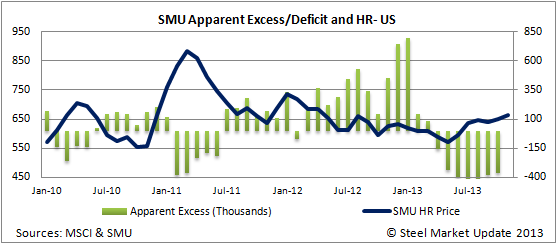SMU Data and Models

Flat Rolled Apparent Deficit Now Stands at 361,000 Tons
Written by John Packard
November 19, 2013
Based on Steel Market Update proprietary analysis of the recently released MSCI shipment and inventory data, we have determined that the Apparent Deficit of flat rolled steel for October now totals 361,000 tons. This is a reduction of 21,000 tons compared to the end of September. At the end of October 2012, service centers had a 142,000 ton excess.

Our opinion is the greater the Apparent Deficit the more material service centers will be required to buy in the coming months in order to get their inventories back into equilibrium. The tighter inventories affect the domestic mills’ ability to raise and collect price increases. As you can see by the graphic below benchmark hot rolled prices began to improve right about the same time service centers dropped from a large Apparent Excess into a Deficit.


John Packard
Read more from John PackardLatest in SMU Data and Models

SMU Survey: Sheet lead times ease further, plate hits one-year high
Steel buyers responding to this week’s SMU market survey report a continued softening in sheet lead times. Meanwhile, plate lead times have moderately extended and are at a one-year high.

SMU Survey: Buyers report more price flexibility from mills
Nearly half of the steel buyers responding to this week’s SMU market survey say domestic mills are showing increased willingness to negotiate pricing on new spot orders. This marks a significant shift from the firmer stance mills held in prior weeks.

SMU Survey: Buyers’ Sentiment Indices fall
Current Sentiment Index dropped six points to +42 this week compared to two weeks earlier. It has fallen in every successive survey since reaching a 2025 high of +66 on Feb. 19.

March service center shipments and inventories report
Steel service center shipments and inventories report through March 2024.

Apparent steel supply contracts in February
The amount of finished steel that entered the US market in February receded from January’s peak, according to our analysis of Department of Commerce and American Iron and Steel Institute (AISI) data.
